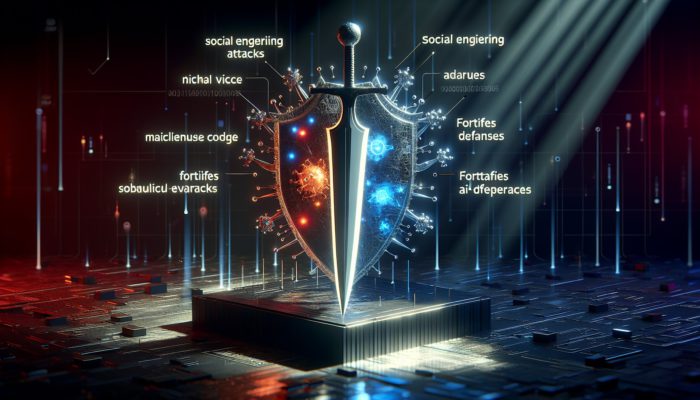Experience the CISO Journey: Mastering the Evolving Cybersecurity Landscape
Welcome to the second episode of Series 3 of the CISO Experience, streaming live on the Infosec Live channel. This engaging series dives into genuine discussions with leading security experts, focusing on the technological advancements, human factors, challenges, and emerging opportunities that are reshaping the cybersecurity environment. Our sponsor, Simple Security, advocates that cybersecurity doesn't have to be overly complex. They are dedicated to offering enterprise-level security solutions that are accessible, affordable, and effective for organizations of all sizes and industries. With their support, businesses can navigate the intricate world of cybersecurity with confidence.
Explore Adam Pilton's Inspiring Transition from Law Enforcement to Cybersecurity Expertise

Today, we are excited to introduce Adam Pilton, a dedicated cybersecurity professional whose career began in 2016. Adam's journey is both inspiring and informative; he started in cybercrime investigation and gradually transitioned into advisory roles. His unique insights combine technical knowledge with practical application, enabling him to translate complex risks into actionable strategies for business leaders. This not only enhances their understanding of cybersecurity protocols but also empowers them to implement effective measures tailored to their organizational needs.
Crucial Insights from Adam's Law Enforcement Background
Adam embarked on his professional journey as a police officer, dedicating 15 meaningful years to this vocation. He led a covert operations unit that comprised three specialized teams: the Covert Authorities Bureau, Communications Data Investigators, and the Cybercrime Team. His responsibilities included securing lawful authorities for covert operations and addressing challenges across both physical and digital domains, thereby gaining a comprehensive understanding of the cybersecurity landscape.
One of the most profound lessons Adam learned from his initial experiences was the significant human impact of cyber threats. He interacted with victims, both individuals and organizations, witnessing firsthand the devastating effects of cybercrime. For instance, the loss of a Facebook account may seem trivial at first glance, yet if it contains irreplaceable memories such as photographs of loved ones, the emotional repercussions can be profound and enduring.
Strategically Transitioning from Law Enforcement to the Private Sector
After 15 rewarding years in law enforcement, Adam realized he had reached the pinnacle of his potential in that role. The limited opportunities for expanding his team’s digital capabilities, alongside the allure of frontline positions, motivated him to transition out of the police service. He subsequently accepted a position at Heimdal Security, drawn by their high-quality offerings and the opportunity to continue making a significant impact in the field of cybersecurity.
Identifying Cybersecurity Challenges and the Need for Proactive Measures

Adam contends that the cybersecurity sector is facing a significant motivation dilemma. Despite the relentless media coverage showcasing various cyber threats, many organizations acknowledge the urgent need for action yet struggle to implement effective solutions. The overwhelming complexity associated with cybersecurity often leaves companies feeling unsure about where to begin their improvement journey, leading to a cycle of inaction.
To address this challenge, Adam advocates for the adoption of frameworks like Cyber Essentials in the UK. These structured frameworks provide a clear roadmap for organizations to strengthen their cybersecurity measures, enabling them to implement fundamental practices while gradually enhancing their capabilities. A recent study found that 60% of individuals who participate in the Cyber Essentials program gain new insights with every attempt, underscoring the significance of continuous education and development in this fast-evolving field.
The Vital Role of Law Enforcement and Government in Cybersecurity Support
Adam emphasizes that law enforcement agencies and government bodies play an essential role in assisting businesses with their cybersecurity needs. However, he also points out the necessity for the industry to improve its approach to delivering support. The outdated tactics of instilling fear, uncertainty, and doubt to market cybersecurity solutions are no longer effective; businesses now require more practical, actionable guidance and support to navigate the challenges they face.
Recognizing Emerging Cyber Threats and Trends in Cybercrime
The landscape of cyber threats has undergone a dramatic transformation over the past decade, with attackers consistently staying several steps ahead of organizations. A notable trend is the resurgence of social engineering attacks, exemplified by groups like Scattered Spider. These sophisticated attacks often target IT help desks, employing advanced techniques that are frequently supported by <a href="https://limitsofstrategy.com/artificial-intelligence-ai-when-a-real-human-is-needed/">artificial intelligence</a>, making it increasingly challenging for organizations to defend against them.
Moreover, Adam highlights the shift in the dynamics of cybercrime, moving from individual hackers to highly organized crime syndicates. These syndicates operate similarly to legitimate businesses, complete with dedicated customer service teams. For example, platforms providing ransomware-as-a-service now offer legal assistance to facilitate ransom negotiations, illustrating the alarming sophistication and professionalism of contemporary cybercrime.
Leveraging AI's Dual Impact on Cybersecurity Enhancement

Artificial intelligence acts as a double-edged sword in the realm of cybersecurity. While it can enhance the effectiveness of social engineering attacks, it also presents invaluable opportunities for defense and fortification. Adam believes that AI will play a pivotal role in empowering businesses to create more secure environments; however, it will also introduce new challenges that must be proactively addressed to avoid potential pitfalls.
Fostering a Security-Conscious Culture in Organizations
Establishing a culture of security awareness is crucial for a robust cybersecurity strategy. Adam stresses the importance of embedding security principles into the very fabric of an organization’s culture, beginning with the development of clear mission and vision statements. This comprehensive approach ensures that every employee understands their integral role in maintaining security within the organization, fostering a sense of responsibility and vigilance.
To effectively engage employees, Adam encourages making training relatable to their everyday experiences. For instance, illustrating the consequences of losing personal data, such as cherished photographs on a social media platform, can significantly enhance their understanding of the importance of cybersecurity in a practical and relatable manner. By connecting these concepts to personal experiences, employees are more likely to internalize the importance of safeguarding sensitive information.
Adopting Frameworks for Continuous Cybersecurity Maturity and Development
For organizations embarking on their cybersecurity journey, Adam strongly advocates implementing structured frameworks like Cyber Essentials. These frameworks offer a clear, methodical approach to establishing security measures, helping businesses avoid feelings of overwhelm while building a resilient foundation. By systematically addressing their cybersecurity needs, organizations can lay the groundwork for long-term success.
He also emphasizes the critical importance of ongoing improvement, as cybersecurity is an unending process rather than a one-time initiative. Organizations must continuously adapt and evolve their security posture to respond to the ever-changing threat landscape and the dynamic environments in which they operate, ensuring they remain resilient against new challenges.
Envisioning the Future of Cybersecurity: Opportunities and Challenges Ahead
Adam expresses optimism regarding the growing public awareness of cybersecurity. As younger generations become increasingly familiar with technology, they bring enhanced understanding of cybersecurity principles into their workplaces. This shift in awareness has the potential to significantly aid businesses in cultivating more resilient security cultures, where every employee plays an active role in protecting sensitive information.
Furthermore, Adam identifies promising opportunities in artificial intelligence that could enable businesses to automate and enhance their security measures. However, he cautions that the rise of AI also presents new challenges that organizations must be prepared to confront in order to leverage its full potential effectively.
Empowering the Next Generation through Cybersecurity Education
Adam asserts that a greater emphasis must be placed on educating children about cybersecurity principles. While educational institutions currently employ varied approaches to teaching these concepts, a more standardized curriculum could better equip the next generation for the complexities of the digital landscape. This foundational knowledge is essential for fostering a culture of security awareness from an early age.
Moreover, parents have a significant responsibility to teach their children about online safety. Adam suggests setting clear boundaries on device usage and educating children about the risks associated with sharing personal information online. By instilling these values early, parents can help prepare children to navigate the digital world safely and responsibly.
Key Takeaways from Adam Pilton's Journey: Overcoming Cybersecurity Challenges
Adam Pilton's remarkable journey from police officer to cybersecurity professional offers invaluable insights into the profound human impact of cyber threats and the urgent need for practical, actionable security measures. As businesses navigate the intricate realm of cybersecurity, structured frameworks like Cyber Essentials can provide a solid foundation for developing a resilient security posture that can withstand evolving threats.
The future of cybersecurity is filled with potential, characterized by heightened awareness and the transformative power of AI to enhance security measures. Nevertheless, this evolving landscape also introduces new challenges that businesses must actively address to maintain their security integrity. By prioritizing security awareness, fostering an inclusive culture, and committing to ongoing improvement, organizations can effectively stay ahead of emerging threats and safeguard their most valuable assets.
The post Cybersecurity Insights: From Police to CISO appeared first on Ezi Gold.
The Article Cybersecurity Insights: Transitioning from Police to CISO Was Found On https://limitsofstrategy.com

